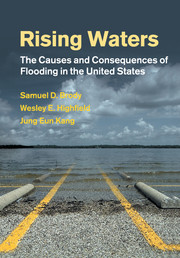Book contents
- Frontmatter
- Contents
- Preface
- Acknowledgments
- Abbreviations
- 1 Introduction: rising waters
- Part I The consequences of floods
- Part II Planning decisions and flood attenuation
- 5 Identifying the factors influencing flooding and flood damage
- 6 The role of wetlands: federal policies, losses, and floods
- 7 Mitigation strategies and reduction of flood damages
- 8 Other factors influencing flooding and flood damage
- Part III What are we learning?
- Part IV Policy implications and recommendations
- 12 Conclusions
- References
- Index
6 - The role of wetlands: federal policies, losses, and floods
from Part II - Planning decisions and flood attenuation
Published online by Cambridge University Press: 28 April 2011
- Frontmatter
- Contents
- Preface
- Acknowledgments
- Abbreviations
- 1 Introduction: rising waters
- Part I The consequences of floods
- Part II Planning decisions and flood attenuation
- 5 Identifying the factors influencing flooding and flood damage
- 6 The role of wetlands: federal policies, losses, and floods
- 7 Mitigation strategies and reduction of flood damages
- 8 Other factors influencing flooding and flood damage
- Part III What are we learning?
- Part IV Policy implications and recommendations
- 12 Conclusions
- References
- Index
Summary
As outlined in Chapter 5, the role of naturally occurring wetlands in regulating streamflow and reducing floods is critically important, especially in the low-lying areas of Texas and Florida. Despite this recognized function, regulations to limit the loss of naturally occurring wetlands have been a moving target since their inception. From the primary agency charged with permitting their alterations, to a patchwork of state and local policies, wetland regulation in the U.S. is a prime example of a constantly evolving environmental policy.
In studying this changing policy climate, previous research has pointed to difficulties mitigating wetland loss through the federal permitting process and has increasingly linked wetland alteration with flooding. This chapter addresses the importance of naturally occurring wetlands by linking federal policy administered by the USACE to record wetland loss and its regional effects on streamflow, flooding, and flood damage. First, we describe the progression of federal wetland policy and the permitting procedures of the USACE. Second, we evaluate the types of wetland loss in Texas and Florida as a result of these permitting procedures. Finally, we analyze the effects of wetland permitting and loss on flooding and flood damage. Our analysis shows that permits issued to alter naturally occurring wetlands in Texas and Florida increase both the degree and impact of flood events.
- Type
- Chapter
- Information
- Rising WatersThe Causes and Consequences of Flooding in the United States, pp. 88 - 102Publisher: Cambridge University PressPrint publication year: 2011



